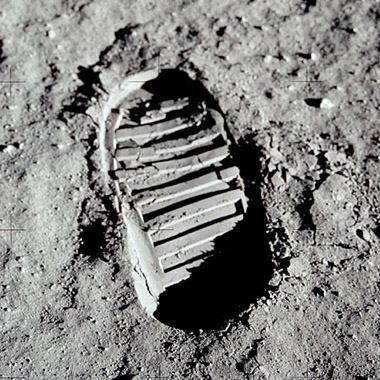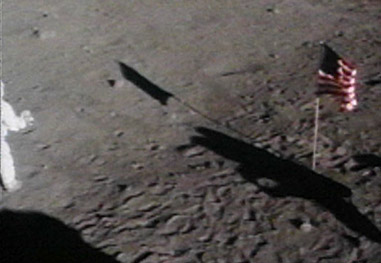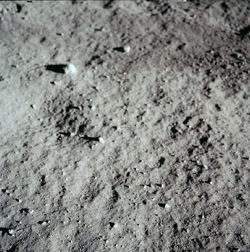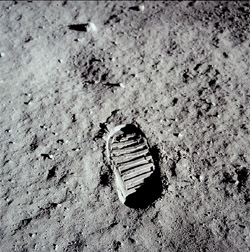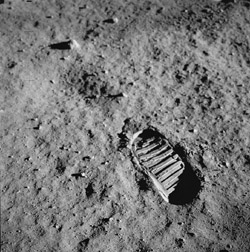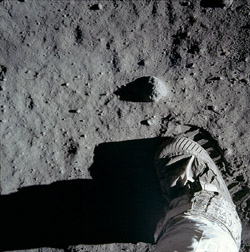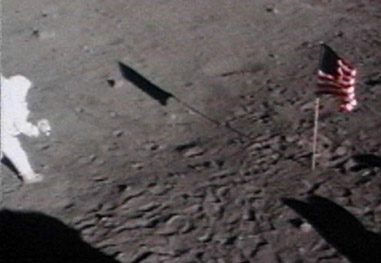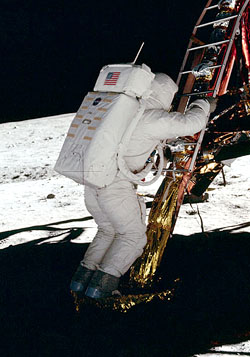|
The first step on the moon[ This text is also available in Swedish ] The iconic photo is not of Neil Armstrongs very first step on the moon. It's not even his footprint. It was made by Edwin E. "Buzz" Aldrin Jr.
The photo wasn't taken for future posters, T-shirts, mouse pads etc., but for a strictly scientific purpose: to study how the moon soil (regolith) would behave when compressed by the boot, and thus learn something about it's geological properties. That's why Aldrin also took a photo of the surface before he made the footprint. One important objective of the Apollo 11 mission was to observe the properties of the regolith and assess how these properties affected the crew's ability to move about and to work on the lunar surface. This investigation was known as the Soil Mechanics Investigation, which on Apollo 11 consisted of verbal descriptions by the crew and close-up photographs of the regolith, including three-dimensional stereo photographs. NASA
The picture above comes from a 16 mm film camera, mounted on the lunar module. Aldrin went to a patch of undisturbed soil, took a photo (what looks like a film camera is his Hasselblad camera, reshaped to be easier to use for the astronauts), made the footprint, and then two more photos. The little stone in front of him can be seen in the photos below. The time, by the way, is 110:25:09, in hours, minutes and seconds from the lift off (though 5876-5878 apparently weren't taken in the same second). The codes are the unique ones with which all photos from the Apollo project were identified. They come from the site Apollo 11 Image Library, where all images from all the projects are published, with comments of varying verbosity. Note that the last photo shows another footprint in front of the other one, next to the little stone. This is what that moment looks like on the 16 mm film; the famous footprint can be seen behind Aldrins foot.
One reason that the footprint couldn't be the very first one can be seen here, with Aldrin just about to step out on the surface.
The astronauts climbed down the ladder, stood in the landing pad, and then took a step backwards; that's why Armstrong said "I'm going to step off the LEM [lunar module] now". If the famous footprint had been the one he then made, the pad would have been in the picture. Is there a picture of man's first footprint? Apparently not. That part of the ground was in the shade during the entire so-called EVA (Extra-Vehicular Activity) which lasted some two and a half hours. In addition, when Aldrin stepped out, he put his foot on the very same spot. Are these footprints still on the moon? The ones next to the lunar module were erased by the rocket thrust when the astronauts left. The effect decreases with distance considerably faster than in an atmosphere, though. In his book Return to Earth, Aldrin mentions that even the flag was toppled over, a piece of information that at least one source I found apparently didn't trust entirely. However, in the following landings, the flag was put a bit further away from the lunar module. It is uncertain if the flag remained standing or was blown over by the engine blast when the ascent module took off. Anne M. Platoff Related about Apollo 11When Armstrong became the first man on the moon, and said his "A small step for a man, a giant leap for mankind", an article apparently disappeared in the radio communication, if not errare humanum est. But the strange phrase "A small step for man, a giant leap for mankind" was obviously not what he intended to say. Thus, it's often referred to as "A small step for (a) man, a giant leap for mankind". "The eagle has landed" - where these the first words uttered when they had landed? Well, the very first were Aldrins matter-of-fact: "Contact light. OK, engine stop." And the Chinese wall? No, they couldn't see it. No way. Finally: There is an amusing anecdote about an additional saying by Armstrong: "Good luck, Mr. Gorsky". Heard about it? - Here's what snopes.com has to tell about Mr Gorsky. Sources:
|


